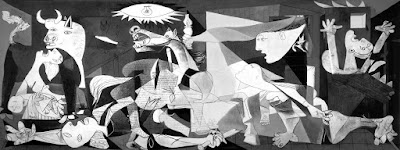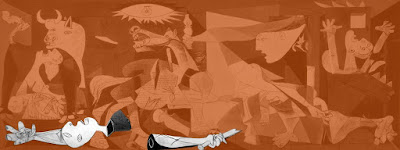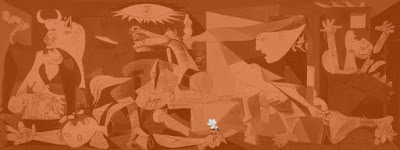Author: Pablo Ruiz
Picasso
Creation: 1937
Location: Queen Sofía
National Museum, Madrid (Spain)
Style: Cubism /
Surrealism / Expressionism
Technique: Oil on canvas
Dimensions: 349,3 x
776,6 cm
Contextualization and theme
It is about a large dimensions
painting made in 1937 by Pablo Picasso for the Republic pavilion in the
Universal Exhibition of Paris the same year. After a lot of years placed in
EEUU, it arrived to Spain being placed permanently in the Queen Sofia Museum.
The theme revolves around the
war horrors. Picasso, facing the Spanish Republic order, which was immersed in
the middle of the Civil War after the military rebellion, was shocked by news
about the Basque city bombing of Guernica. The news were headline in all the
newspapers that highlight the brutality of the action applied over a small city
without military interest, disarmed and only occupied by civil population. With
this leitmotiv, he begins to build the great canvas.
Through many notes and several
versions of the complete painting, Picasso, little by little, is started opting
for bombing specific motifs to concentrate all the violence over emblems and
figures that stop referring to the specific incident. In this process, Guernica
stop being a pure historic painting to turn into a shout against war from the
point of view of the victims, a reflection about destruction and pain
applicable to any type of conflict, changing a specific incident in a universal
work, understandable without necessity of knowing the specific details.
Characters´s symbolic interpretation
Regarding the represented
characters, all of them are victims, without any soldier appearance. Its
interpretation has been very questioned, being refused reiteratedly by the
painter to give them a specific meaning.
The bull: reading the painting from left to right and from top to bottom the first
figure with which we find is the bull. It is a recurrent symbol in Picasso´s
works and, in this case, normally it is assimilated as a self-portrait. It is
interpreted as the author horrified by such atrocity, with a knife shape ears
listening the pain shouts and protecting the mother´s figure who is positioned
just under him. So the bull is him, the same Picasso, the necessary witness to
cry out for world about the war brutality.
The mother with her son: just under the bull it is found, protected by this animal, the figure of
the mother who holds his dead son. This figure, as many of you have deduced, in
the same way as the composition, is classical as well: The Pietà, symbol of
mother´s pain per excellence.
In this composition it is very
important the characters’ heads. On one hand, child´s head, dramatically fallen
and rolled child´s eyes without pupils, makes us guess he is dead. On the other
hand, the mother, whose head´s position makes us guess she is looking for the
impossible relief of heaven, or even the animal. Her eyes, very important for
this character, have a tear shape, another more symbol of woman´s distress,
besides the sharp tongue that introduces a dying pain scream in our minds.
The warrior: drawing the triangle base of the composition it is found the dead warrior
at the bottom of the painting. In the initials sketches this character was
represented as a great classical hero, with his Hellenic helmet and the spear
close to his body, but in the final project that idea was rejected. In this way
it is transmitted that idea of characters´ vulnerability, representing that the
city was defenceless against the cruel attack.
The lights: paying attention to the painting general composition another time, it is
seen perfectly how both spotlights are at the peak of the pyramidal hierarchy. And
it is that both spotlights represent both big powers and Spanish Civil War
sides. On one side, the enormous lamp is introduced to us as a big controlling
eye that can see all and want to dominate all. Just to its side, a small oil
lamp strongly grabbed by a civilian´s beautiful and muscular arm that makes his
way facing the disaster. In this way it is presented to us a duality, the Civil
War duality, good and evil duality.
Apart from the objects, the
fact of dealing with the spotlights gives us cause for analysing the light
itself. During a large part of the History of Art the light has been a beauty,
strength, honour bearer. In this painting, by the contrary, it is introduced to
us the light as an exterminating object, as the tool that is used to the night
slaughter.
Referred to the oil lamp
bearer character, many experts agree with the fact that it is an allegorical figure
of the Republic that, devastated by all that its eyes is seeing, is taken its
hand to its chest, a universal patriotic symbol.
The horse: it is about
the painting main object, optically talking due to its location and size inside
the work. In this one it is perceived a big rhomboid wound, with an extreme
contrast between black and white colours, emphasising in this way the horrors
and brutality of the situation. Besides the author places in the animal a spear
that go through him mortally, an engraved symbol in his mind – in the same way
that the bull – thanks to a bullfight the author attended in his visit to Spain
in 1934.
Another essential detail to
understand in a good way the painting is hidden in the texture that Picasso and
Dora, his second lover, gave to the animal body. If we observe the combination,
we can realize how that texture favours that the horse body is dissolved in a
sea of newspapers letters. The marks are illegible but above them it is the
head that dominates all the things, the force of the Art makes its way between
the news buzz.
The lame woman: this woman, who seems to try to scape of that situation, is gone towards
the light although she seems to be paralysed by the horror that this one lights
up. From this figure stands out the left leg that many critics consider already
dead, by the colour it has in comparison with the other leg of the same figure.
Her arm seems to place in that lower extremity to cover a possible haemorrhage.
Another time, another figurative character related to another war horror: the
attempt of survivors´ scape.
The man (woman?) in flames: this character, represented to the left of the painting, represents, for
many, the Guernica citizens who died because of incendiaries bombs rain that
finished destroying the settlement. This person, placed as the main character
of the executions by firing squad in 1808, the 3rd of May painted by
Francisco de Goya, raises his arms to the heaven as begging to the relentless
air force that stops bombing the city.
The pigeon: in the middle of this horrible chaos the artist decides to put a small
and almost indistinguishable reference to peace: a pigeon. It would be possible
to wait that this one could have an essential role in the painting or, at
least, a pure white colour, but it doesn´t. The artist represents in this way
the broken, dirty and murdered peace of the people by the Italian-German
troops. A peace that, jointly the represented characters, seems to exclaim to
heaven that the violence stops.
The flower: in the Guernica initials sketches, Picasso shows quite more hope symbols
that the timid represented flower at last. He starts with a raised fist, with
Pegasus emerging from the horse wound… but he finishes with a simple and humble
flower.
Why does hope finish repressed
in that tiny flower? Because Picasso doesn´t represent the Spanish nation´s resurrection,
he doesn´t represent the hope of getting a better world, Picasso represents his
own version of Goya´s War Disasters. Here there is no hope, there is only space
to brutality and despair. This is war. This is Art.
Compositional organization and drawing technique
The composition reminds the
triptych compositions, divided in three areas. The central one is ordered in a
triangular shape around the horse, including in its low area the statue and the
woman who moves forward. To both sides of this central group it is created two rectangular
triangles that are balanced out in their figures. Everything that has been said
confirms us a strong scene study, looking for a clear organization and based in
a well-delimited areas that permit a better scene comprehension, thought to its
exhibition in the presence of a non-understood audience.
The drawing takes part in
these techniques renovation explained previously. Over it we can discover Picasso´s
previous experiences, as cubism. Departing from the idea of negation referred
to the unique point of view, the figures are studied from several places,
joining after that the different visions in a more complex image (because it provides
with more information) though in a different way in relation to the usual one
(simultaneous vision). In this manner, the bull has both eyes at the same level
or the different anatomical parts of the horse belong to opposite point of
views (see the head).
Beside this technique is
observed other typical references to contemporary representation. In certain
places it can be appreciated the figures deformation that Picasso makes to give
them more expressivity, as it happens with the horse head, the woman´s enlarged
hands who hold her dead son or the woman´s on the right deformed legs. In the
same way, it is produced objects attributes transfers, making into one´s
another, just like it happens in the tongues that are made into sharp objects,
like knifes, or in the extreme women´s eyes where the eyes have been made into
their own tears.
These two last features leave
from surrealism world which Picasso frequents at the end of the twenties and in
the thirties. His expressive liberty idea is patent as well in certain
suggestions from the children´s drawing that appears in the painting and the
painter was discovering in that moments. From that experience (the children´s
drawing doesn´t draw things as it sees but as it knows) he reduces some
elements to its pure visual essence, giving enough data so that the image,
without being a copy from reality, was understandable, just like it happens in
the statue flower or the bulb drawing.
Colour, light and space
The colour and the light work
in a joint way. From the first moment, Picasso thought in the painting as a
black and white image that, in its chromatic limitation, could transmit all the
atmosphere of pain and tragedy. Over this background, the characters´ dramatic
expressions put on hold, as terrifying shouts inside a general silence in which
the pain absence collaborates, though not the tones, because the grey colour,
in different gradations, calms and gives cohesion to the black and white sharp
contrasts (see the horse head).
Referred to the light, already
disassociated from reality naturalist recreation (classical chiaroscuro), it
lights up the scene without obeying any spotlight type. It is about an unnatural
light that is useful, above all, to guide us into the painting creating effects
that emphasize the drawing (the hand that carries the oil lamp crossed by
different shadows or the shadow effect shined by the statue hand) or the
tragedy (the window strongly lighted up in the left side, too small to be able
to leave the fire). In general, the main characters appear strongly lighted up,
without shadows that emphasize their two-dimensionality.
The space, over all at the beginning,
can seem difficult to understand. Its strangeness is produced by the
perspective disappearance, typical from Renaissance. From the first cubist
experiences the idea of the painting as a window disappears. No longer it is
expected the real representation of the world, and the canvas is turned into a
two-dimensional space that renounce to the background, giving us all the images
in the same level. No longer it is turned to the trick of doing things smaller
dependent on the distance to the spectator and, in the same way, it is
eliminated the chiaroscuro that modelled the shapes. Just in any places (statue
neck, horse head…) it is preserved a certain traditional representation that is
still good to facilitate the images lecture.


























